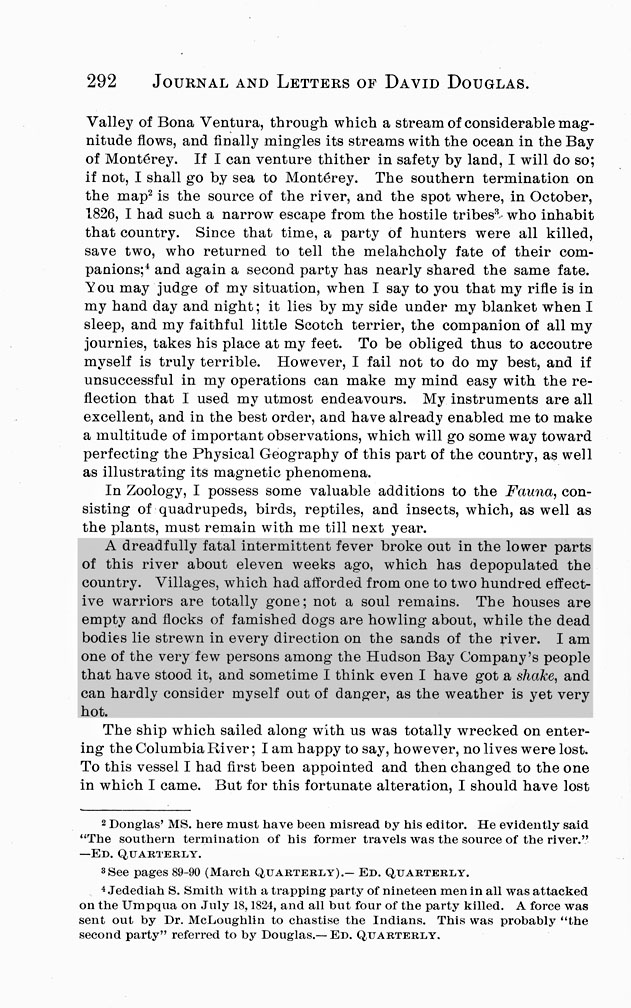- Catalog No. —
- OHQ 6 : 192
- Date —
- October 11, 1830
- Era —
- 1792-1845 (Early Exploration, Fur Trade, Missionaries, and Settlement)
- Themes —
- Environment and Natural Resources, Exploration and Explorers, Native Americans
- Credits —
- Oregon Historical Society, Oregon Historical Quarterly
- Regions —
- Columbia River Oregon Country
- Author —
- David Douglas
From David Douglas to William Hooker
This document is an excerpt from a letter written by botanist David Douglas in October 1830. It was published in the Companion to the Botanical Magazine in 1836 and republished in the Oregon Historical Quarterly in March 1905.
Douglas, who had come to the Oregon Country to study natural history, describes a “dreadfully fatal intermittent fever” that ravaged the lower Columbia River region in the early 1830s. Also referred to as “fever and ague,” the disease was probably malaria, a mosquito-transmitted illness that can bring fever, shakes, hallucinations, and, eventually, death to its victims.
A series of epidemics depopulated Native villages up and down the Northwest Coast beginning in the 1770s. The Chinookan peoples of the lower Columbia River were especially susceptible to introduced diseases because of their dense settlements and their extensive contact with non-Native explorers and traders.
Douglas describes bodies lining the shore of the Columbia River during the outbreak of 1830, which was one of the worst of the many epidemics that swept through Native communities during the early contact period. Plunging into the cold river after taking a sweat bath was a common response to the fever and ague, but it often proved instantly fatal. Victoria Howard (1865-1930), a Clackamas Indian woman, later told anthropologist Melville Jacobs that “when some of them were feverish, they would run to the river, they would go and swim in it, they would go ashore, they would drop right there, they would die.”
Native communities were so devastated by the disease outbreak of the early 1830s that the dead laid unburied on the banks of the river and in the villages. Between the 1770s and the 1840s the Native population of the lower Columbia River and the neighboring Willamette Valley declined by more than 90 percent as a result of malaria, measles, smallpox, and other diseases introduced by white traders and settlers.
Further Reading:
Boyd, Robert. The Coming of the Spirit of Pestilence: Introduced Infectious Diseases and Population Decline among Northwest Coast Indians, 1774-1874. Seattle, Wash., 1999.
Harris, Cole. “Voices of Smallpox around the Strait of Georgia,” in The Resettlement of British Columbia: Essays on Colonialism and Geographical Change. Vancouver, B. C., 1997.
Silverstein, Michael. “Chinookans of the Lower Columbia,” in Handbook of North American Indians: Northwest Coast. Vol. 7, edited by Wayne Suttles. Washington, D.C, 1990.
Written by Cain Allen, © Oregon Historical Society, 2004.
